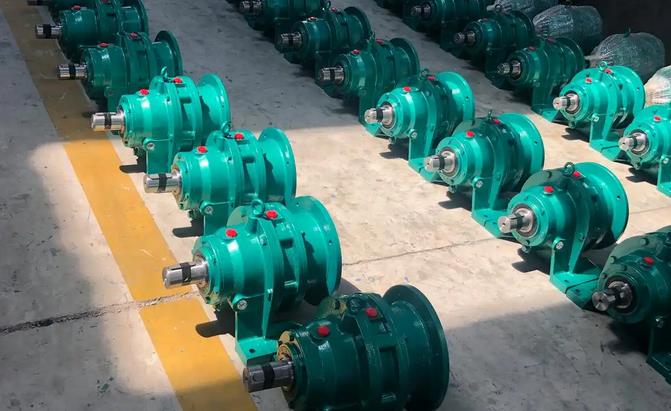Advantages of XWD4-23-4KW single-stage horizontal cycloidal pinwheel reducer for metallurgical machinery
The XWD4-23-4KW single-stage horizontal cycloidal pinwheel reducer for metallurgical machinery has the following advantages:
Large reduction ratio: The first stage transmission reduction ratio is 9-87, the two-stage transmission reduction ratio is 121-5133, and the multi-stage combination can reach tens of thousands, which can meet the reduction needs of different equipment.

High efficiency: The needle tooth meshing system has sleeve type rolling friction, with no relative sliding on the meshing surface. The first stage deceleration efficiency reaches 94%, which can reduce energy loss while transmitting the same power.
Smooth operation: During operation, there are multiple pairs of teeth in contact, with a high degree of overlap and smooth operation. It has strong overload capacity, low vibration and noise, and various specifications of models have low noise, providing stable power transmission for the equipment.
Reliable use: The main components are made of high carbon alloy steel quenched (HRC58-62) and then finely ground. The cycloidal teeth mesh with the needle gear sleeve and transmit to the needle teeth to form a rolling friction pair. The friction coefficient is small, so there is no relative sliding in the meshing area, and the wear is minimal. It is durable and has a long service life.
Compact structure: Compared with other reducers of the same power, the weight and volume are more than one-third smaller. Due to the planetary transmission, the input shaft and output shaft are on the same axis to achieve the smallest possible size, which can save equipment installation space.
There are various installation methods: the machine can be assembled in horizontal, vertical, dual axis, and direct connection types, which can meet the installation requirements of different equipment.
Convenient maintenance: The design is reasonable, the maintenance is easy, it is easy to disassemble and install, the number of parts is small, and simple lubrication makes the cycloidal pinwheel reducer highly trusted by users, reducing equipment maintenance costs and downtime.
Strong overload capacity: It has strong overload capacity, can withstand large impacts and inertia moments, and is suitable for situations with frequent starting and forward and reverse rotation.
It has the following advantages:
Large reduction ratio: The first stage transmission reduction ratio is 9-87, the two-stage transmission reduction ratio is 121-5133, and the multi-stage combination can reach tens of thousands, which can meet the reduction needs of different equipment.
High efficiency: The needle tooth meshing system has sleeve type rolling friction, with no relative sliding on the meshing surface. The first stage deceleration efficiency reaches 94%, which can reduce energy loss while transmitting the same power.
Smooth operation: During operation, there are multiple pairs of teeth in contact, with a high degree of overlap and smooth operation. It has strong overload capacity, low vibration and noise, and various specifications of models have low noise, providing stable power transmission for the equipment.
Reliable use: With a low coefficient of friction, there is no relative sliding in the meshing area, minimal wear, durability, and long service life.
Compact structure: Compared with other reducers of the same power, the weight and volume are more than one-third smaller. Due to the planetary transmission, the input shaft and output shaft are on the same axis to achieve the smallest possible size, which can save equipment installation space.
There are various installation methods: the machine can be assembled in horizontal, vertical, dual axis, and direct connection types, which can meet the installation requirements of different equipment.
Convenient maintenance: The design is reasonable, the maintenance is easy, it is easy to disassemble and install, the number of parts is small, and simple lubrication makes the cycloidal pinwheel reducer highly trusted by users, reducing equipment maintenance costs and downtime.

